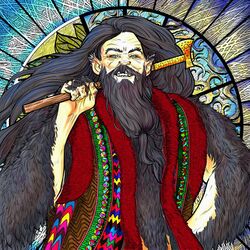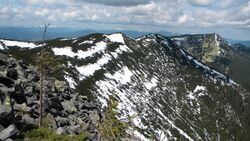Religion:Chuhaister
Illustration of Chuhayster | |
| Grouping | Male legendary creatures |
|---|---|
| Sub grouping | Fairy Spirit Relict hominid |
| Folklore | Slavic paganism |
| First attested | In folklore |
| Other name(s) | Ukrainian: Чугайстер |
| Country | |
| Region | Ukrainian Carpathians |
The Chuhaister (Template:Lang-ukr[1]) is a Ukrainian tutelary deity of the forests. He is specific to the Ukrainian Carpathians. It's a fantastic image in Ukrainian mythology, unknown to other Slavic peoples.
Description
He was imagined as cheerful and overgrown with black or white fur and blue eyes. He dances, sings, and hunts Mavkas that lure young woodcutters and shepherds into the wilderness and destroy them. There was a belief that this was a man who had been cursed by sorcerers, who had been "done to", i.e. given a reason. Sometimes Chuhaister was imagined in the form of a wind or a whirlwind. He was said to have a cheerful disposition and loved to dance and sing. It was believed that the Chuhaister hunts down female spirits (Mavkas, Povitruli) that are dangerous for people and eats them.
For a person, according to most ideas, the Chuhaister is not dangerous. He likes to sit by the human fire and roast the caught Mavka on it. Sometimes the Chuhaister takes people into a crazy dance which shoes cannot withstand. Chuhaister also took his place in works of art based on Ukrainian folklore.
Names and etymology
Known by the following names: chugayster, chugaystyr,[2] chugaistryn, ochugayster, chugay, forest man, forest grandfather and simply grandfather (Boykivshchyna), night owl (Transcarpathia), grove (Rakhivshchyna), grandfather. The use of such names as grandfather is probably connected with the taboo against saying the names of demons out loud. Some authors capitalize the name of the character, considering him as an individual.[3]
The most known names for Chuhaister include the following:
- Lisovyi cholovik (Template:Lang-ukr) "Forest man"[4]
- Lisovyi did (Template:Lang-ukr) "Forest grandfather"
- Nochnyk (Template:Lang-ukr) "Night Person"
- Hai (Template:Lang-ukr) "Grove"
The origin of the word chugaister has not been finally clarified. Modern researchers connect the first element of the word with Prosl. *čuga[what language is this?] ("ambush, sentinel"), chuga[what language is this?] ("Cossack watchtowers"), chuga[what language is this?] (Carpathian national outerwear), chugilo[what language is this?] ("flow in the stone"), chuga[what language is this?] ("scarecrow", "scarecrow" in the dialect of the village of Negostyna) . At the same time, the origin of the second part (a)ystyr remains unexplained, although some researchers derive it from the dialect gaister (Template:Lang-ukr). The foreign origin of the word is also assumed.
Spreading the myth and researching the image
Legends about Chuhaister are known only in the Ukrainian Carpathian Mountains, they are most widespread in the Hutsul Oblast. The word Chuhaister does not appear in historical monuments. B. V. Kobylansky assumed that the mythological character and his name arose directly in the southwestern dialects of the Ukrainian language in connection with the appearance of forest hermits from Moldavian-Bukovinian monasteries in the 17th-18th centuries.
There are few folklore records and scientific publications about Chuhaister. At the beginning of the 20th century the writings of V. Y. Shukhevich in his "Hutsulshchyna" (Lviv, 1899—1908) and A. I. Onyshchuk in the work "Materials for Hutsul demonology" (Lviv, 1909) and the mention of V. Hnatyuk in the work "Remains of the pre-Christian religious worldview of our ancestors" (Lviv, 1912), then a couple of articles by I. A. Pankevych in the book "Ukrainian dialects of Pidkarpatska Rus' and neighboring regions" (Prague, 1938). A few more records were published starting from the second half of the 1980s, including S. G. Pushyk in the article "Chuhaister: a mythical character of Carpathian folk poetry" (Kyiv, 1994). Information about the Chugaist can be found in the dictionary "Hutsul Mythology. Ethnolinguistic dictionary" (Lviv, 2002) N. V. Hobzei.[5] The image was popularized by M. M. Kotsyubynskyi in "Shadows of Forgotten Ancestors", where the Chugaist is bred as a kind and cheerful inhabitant of the Carpathian forests, a protector of people from monkeys. According to S. G. Pushyk, the original ideas about this mythical character were distorted by narrators, in particular, in children's literature.[6]
Appearance
According to the legend, Chuhaister was once an ordinary person. He did something very bad to his neighbor and he cursed him to live in the forest for the rest of his life and not be able to die. Under the power of the curse, Chuhaister left his native home and wandered away. Since then, he wanders alone through the dark dense forests and wild mountain peaks in summer and winter, and no one can harm him - neither man nor beast. Over the years, his clothes have worn out, and Chuhaister now walks around naked. He has long hair and a white beard, his body is covered with white or black fur, so it is very difficult to recognize a person in him. Usually Chuhaister was presented as a giant: healthy, as tall as a spruce - from two to seven meters tall. There are indications that he has blue or frog-like eyes, that he is toothless and lisping, that he has claws on his feet or even hooves. Sometimes Chuhaister was described as dressed in white clothes. There are legends according to which there is only one forest man, or that seven brothers became Chuhaisters, or that there are only three or four Chuhaisters.[7]
He could also be represented as a small spirit that floats in the form of a strong wind or whirlwind and tears down the forest. Wind, rain, thunder, hail and the abnormal movement of the moon in the sky could serve as signs of the presence of the Chuhaister. To make hail, the forest man freezes the lake, then grinds the ice into pieces and lifts them up, carrying them wherever he wants.
It was believed that a forest person always lives in the forest, and he does not show himself in the fields and in the villages, because the air there is "not sweet" for him. It is active mainly at night. According to some beliefs, the forest grandfather has his own farm. However, there are no records of his family. Forest animals are at his service, for example, a fox and a wolf go to fetch him water. It was often believed that the Chuhaister had a cheerful disposition and loved to dance, sing and play the flute. It was also said that he runs fast on one leg or that he can tear off his leg and chop wood with it. He sleeps, curled up in a ball, or in a thicket, or in dry leaves and branches, or near a campfire left by people. In the latter case, he can be represented in the form of a snake-like creature, coiled around the fire with a wheel.[8]
According to folk beliefs, the Chuhaister hunts for forest mermaid-like female spirits (forest maidens): meowers, povitruli, forest witches, lisovi, red ones, devils. Knowing the paths they take, he hides in the leaves and waits for his victim to appear. As she walks by, he jumps out, grabs her and rips her in half (stepping on one leg and pulling the other), then eats it. According to some Hutsul ideas, when a forest man pursues his victims, he is accompanied by a strong wind. The Chuhaister rages if its prey tries to run and hide, its booming voice echoing through the howling of the storm in the treetops. Trying to hide, mavki can run into bedrooms, and even ask people to hide them from the pursuer, but the Chuhaister catches up with them there as well. In order to match the povitruli, the forest man could turn into a wolf, because they are not afraid of wolves. Sometimes in the forest you can hear how the killed povitrulya cries. According to one explanation, the forest man hunts the povitruli, because they make fun of him, depicting his cry - from this, the forest echo occurs. By hunting the forest maidens, the Chuhaister prevents the harm they can do to people, especially men working in the forest. There was a belief that if it weren't for Chuhaister, the "reds" would have bred so much that they would have destroyed people. The function of catching and tearing forest witches in the Carpathians was also attributed to ghouls and wild people.[9]
Habits

Chuhaister helps people in the forest and in the mountains. According to folk beliefs, Chuhaister is friendly to people, he likes talking to them, and warming himself by the fire.[10] Having met a living soul in the forest, Chuhaister will not harm them, but politely invite them to dance, playing his flute. Chuhaister has many features which make him similar to the wind. He can appear in the form of a wind or a whirlwind. Like the wind, Chuhaister can climb into a chimney and sing songs there. He dances like a whirlwind, very fast. Chuhaister's dance is disastrous for ordinary people, it is so fast that no shoes can survive it. However, Chuhaister can also reward a good dancer. During the dance, Chuhaister sings in a lisp: "People play and sing with each other, and we are like that, like that!" (Record of S. Pushyk). It is this lisp that makes you think that Chuhaister belongs to otherworldly creatures. Extremely old, sometimes toothless, he may not be able to pronounce all the sounds.
On the other hand, Chuhaister's affection for people, his protective function (destruction of Mavkas) indicates that he may be an ancestor protecting lumberjacks and hunters from captivity. Kulish and banush are offered as a sacrifice to Chuhaister, minding his lack of teeth. It is often said that Chuhaister is "one-legged." He, like Baba Yaga, can tear off his artificial leg - and chop firewood with it. In a Chuhaister's forest, one should not whistle or shout, so as not to summon the Forest Man. All these are the signs of the "lower world" creatures: one-leggedness or lameness, as well as being summoned with a whistle, are their signs.
Chuhaister and people
It is usually indicated that the Chuhaister is not dangerous for people and even treats them with sympathy, greets them when they meet and urges them not to be afraid of him. He likes to warm himself, talk to someone and smoke his pipe by a manmade fire in the forest, or to roast caught Mavkas on it, having pierced them with a stick like a skewer. In winter, in order to keep warm, Chuhaister could climb into a chimney and sing to the wind there. One story tells of a shepherd who woke up at night and saw Chuhaister by his fireplace. Being an experienced man, he struck the floor in front of Chuhaister with an ax butt downwards, thus gaining power over him, and ordered him to sit on the ax's blade, grabbed him with his little fingers and did not let go until the Chuhaister told him about tomorrow's attack of bears and wolves on the shepherd's herd. In another story, Chuhaister engaged a lumberjack in a frenzied dance, while chanting these word: "People are playing and singing, and we too ourselves are saying this and that, this and that!" Having danced to his heart's content, he let go of the frightened man, who lost his new boots in the dance; while another man could not survive the fast pace of the Chuhaister's dance and either die or be thrown away, for example, into a river.
In the village of Bystrets, Ivano-Frankivsk region, it was believed that Chuhaister grazes his goats and goats of humans on the pastures of еру Gagzhina polonyna. There they also believed that the Chuhaister patronized the masters. Carpathian loggers left Chuhaister as a sacrifice, knowing about his tall stature and toothlessness, with kulish soup and banush porridge. Their disappearance was considered as proof of the arrival of the Chuhaister and their destruction of evil spirits in the cradle. The shepherds turned to the forest man, having first prayed to God that he would not hit the cattle with hail, for this the shepherds put salt with a piece of bread in a cloth at the crossroads.
In another tale, Chuhaister taught a good lesson to a master who had been unfair to his servant by letting a bear attack the master so that he lost all his clothes while running away. Another legend tells about a woman who could not conceive and came to Grandfather Chuhaister for help, so he gave her two daughters, but they could not live separately - one had no hands, and another was blind, so they helped each other out thus symbolizing both mental and physical work. Chuhaister could help a lost person to get out of the forest.[11]
Hutsuls believed that if a forest person sees a fire in a hut at night, he goes straight to it and calls: "Go, go, go!". But it is impossible to answer him, as well as to all spirits, because the answer connects the human world with the world of spirits; the answered forest person can "confuse" (that is, send him a disease) or strangle him. The forest man himself will go into the cradle and check whether there is enough water in the buckets with the sticks that are used to light the fire and stir the kulish. If he likes everything, then he will sit on a stump in front of the fire, saying "Oh, I'll warm up here ...", and will ask various questions to sleeping people, for example, "Hey, are you sleeping?", Again, you don't need to answer them. If he doesn't like something, he can start scaring the herd, hitting with hail. If there was no water supply in the house, the Chuhaister could take the child with him (S.G. Pushyk suggests that in order to protect him from a possible fire).
See also
- Ochopintre (Republic of Georgia)
- Ukrainian folklore
References
- ↑ Шнуренко, Т. В. (2014-07-01). "ДОСЛІДЖЕННЯ ТРАДИЦІЙНОЇ СОРОЧКИ КАРПАТСЬКОГО РЕГІОНУ НА СТОРІНКАХ ЖУРНАЛУ НАРОДНА ТВОРЧІСТЬ ТА ЕТНОГРАФІЯ". Вісник КНУКіМ. Серія «Мистецтвознавство» (30): 138–145. doi:10.31866/2410-1176.30.2014.159838. ISSN 2616-4183.
- ↑ "Інститут українознавства імені І. Крип'якевича НАН України" (in uk), Вікіпедія, 2022-07-16, https://uk.wikipedia.org/w/index.php?title=%D0%86%D0%BD%D1%81%D1%82%D0%B8%D1%82%D1%83%D1%82_%D1%83%D0%BA%D1%80%D0%B0%D1%97%D0%BD%D0%BE%D0%B7%D0%BD%D0%B0%D0%B2%D1%81%D1%82%D0%B2%D0%B0_%D1%96%D0%BC%D0%B5%D0%BD%D1%96_%D0%86._%D0%9A%D1%80%D0%B8%D0%BF%27%D1%8F%D0%BA%D0%B5%D0%B2%D0%B8%D1%87%D0%B0_%D0%9D%D0%90%D0%9D_%D0%A3%D0%BA%D1%80%D0%B0%D1%97%D0%BD%D0%B8&oldid=36553526, retrieved 2022-10-04
- ↑ 100 naĭvidomishykh obraziv ukraïnsʹkoï mifolohiï. Olena Talanchuk, Viktorii︠a︡. Zavadsʹka. Kyïv. 2002. ISBN 966-96200-0-7. OCLC 52773500. https://www.worldcat.org/oclc/52773500.
- ↑ "Електронна бібліотека "Культура України"". https://elib.nlu.org.ua/object.html?id=443.
- ↑ Дмитрук, I. (2010). "Мiфологiчнi уявлення гуцулiв в етнографiчних дослiдженнях кiн. ХIХ-ХХ ст". Народознавчі зошити (5–6): 700–706. ISSN 1028-5091. http://www.irbis-nbuv.gov.ua/cgi-bin/irbis_nbuv/cgiirbis_64.exe?I21DBN=LINK&P21DBN=UJRN&Z21ID=&S21REF=10&S21CNR=20&S21STN=1&S21FMT=ASP_meta&C21COM=S&2_S21P03=FILA=&2_S21STR=NaZo_2010_5-6_30.
- ↑ (in uk) Мовознавство. Наукова думка. 1980. https://books.google.com/books?id=GGNgAAAAMAAJ&q=%D1%87%D1%83%D0%B3%D0%B0%D0%B9%D1%81%D1%82%D0%B5%D1%80.
- ↑ Slavi︠a︡nskiĭ i balkanskiĭ folʹklor. Verovanii︠a︡, tekst, ritual. Nikita Tolstoĭ, Institut slavi︠a︡novedenii︠a︡ i balkanistiki. Moskva. 1994. ISBN 5-02-011499-5. OCLC 31498334. https://www.worldcat.org/oclc/31498334.
- ↑ "Чугайстер — Українська міфологія". 2015-02-24. http://proridne.net/%D0%A3%D0%BA%D1%80%D0%B0%D1%97%D0%BD%D1%81%D1%8C%D0%BA%D0%B0%20%D0%BC%D1%96%D1%84%D0%BE%D0%BB%D0%BE%D0%B3%D1%96%D1%8F/%D0%A7%D1%83%D0%B3%D0%B0%D0%B9%D1%81%D1%82%D0%B5%D1%80.html.
- ↑ "У кого вірили наші предки - бестіарій по-українськи - Чугайстер допомагає людям в лісі і в горах, чорт спокушає дівчат у вигляді панича, злидні призводять до страшної бідності, а від зла рятує тільки хитрість | СЕГОДНЯ". 2015-02-24. http://ukr.segodnya.ua/life/stories/v-kogo-verili-nashi-predki-bestiariy-po-ukrainski-593024.html.
- ↑ "Error: no
|title=specified when using {{Cite web}}". 2015-02-24. http://www.svit.in.ua/kny/voropaj/znn_t2.pdf. - ↑ Демоны въ народномъ вѣрованіи. Demons in folk belief // Russian word. - 1940. - No. 180. - P. 3.
 |





